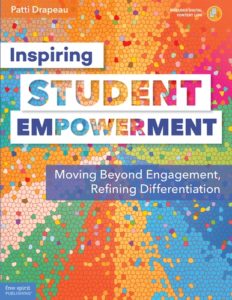Is “Engagement” Enough in the New Normal?
By Patti Drapeau
 Engagement provides a launchpad for empowering students. If students are not engaged, they certainly are not empowered. This was true before COVID-19, and it is still true today.
Engagement provides a launchpad for empowering students. If students are not engaged, they certainly are not empowered. This was true before COVID-19, and it is still true today.
According to the 2016 Gallup Student Poll, 75 percent of fifth graders said they were “engaged” in learning. Is 75 percent good enough? Do we want 25 percent of our students disengaged? Is that a number we can live with?
When we look at middle and high school, the numbers are even more alarming. In that same Gallup poll, only 34 percent of twelfth graders said they were engaged. Do you wonder why student engagement in school diminishes over time?
Engagement increases when students:
• know the purpose of why they should be engaged in a lesson,
• understand what they need to do to accomplish the lesson, and
• put forth effort and commitment in their work.
That describes the “what” of engagement. But not the why. Even though students may be told by their teacher that they need to learn something, and they understand what they need to do to complete the task, they may still lack commitment. Students develop deep and lasting engagement when they feel empowered to learn through their own initiatives.
Engagement increases when students are interested in the content, activity and/or assignment.
Ethan Yazzie-Mintz found when students were asked why they were bored, 81 percent said the material was not interesting. One way to make content more interesting and empower students is to use a problem-based learning approach.
For example, students might not be interested in learning about energy sources. However, you can create a fictional scenario where everyone in the classroom lives in communities on Planet X. Each community (or group of students) must choose one source of energy to use in their fictitious living environment. After researching and choosing the energy source, they present their choice along with their findings to the Galactic Council that rules the planet. The council gives final approval to the community.
Now, you’ve created a much more interesting way for students to learn about the pros and cons of using different energy sources. You’ve also empowered students to make a choice and use their voice.
This type of empowerment strategy can be used in the face-to-face classroom and it can also be used with remote learning. Students can form virtual groups online. Zoom provides breakout rooms where students meet, and the teacher can pop in and check on the group discussions. This type of learning can supplement or replace a textbook chapter on energy.
Student engagement increases when students are curious.
Yes, you can often hook students’ attention by showing them an object or providing them with a statistic and having them guess what the upcoming content will be about. This may engage them, but it will not empower them. When you empower students, you do not do the work – they do.
For example, students find an object and ask the students in the classroom to guess what content information is related to the object. In this scenario, students are empowered to choose the object and use their voice to lead the activity.
This works well in the classroom or in a synchronous learning environment. Online, students can place their guesses in the chat box, on Jamboard, etc. They can call out their answers, or the student leader can call on students to respond. If students are uncomfortable calling on their peers, they can use a deck of cards to call on students.
If there are more than 13 (the number of cards in a suit) people in the remote class, the leader can assign students a group/suit and a number. For instance, Mario can be #7 in the group Hearts. Elvira can be #7 in the group Diamonds. When the leader turns over a card, the card will determine who needs to respond.

Attention is a key to engagement and empowerment.
Students need to pay attention to how they are feeling in order to determine what they need to make learning more meaningful. Know thyself!
In the Affective Perspectives model, students ask themselves what they notice, what they feel and what they need to be more comfortable in a situation. If students notice that they do not want to do an assignment, they should learn to pay attention to why they are feeling this way. Is it they are not interested in the content, or don’t they like the type of assignment?
This is important information for the student and the teacher to realize because they require different types of solutions. One solution focuses on varying the content, the other solution requires scaffolding to help the student accomplish the task.
It may mean the teacher needs to use more charts, lists, visuals or word substitutions in order to avoid tune outs. It may also mean the student prefers a different type of assignment. We sometimes see this if the assignment involves a lot of writing. Maybe the student can record the response rather than write it.
Teach students to pay attention to how they feel so that they can self-advocate for what they need. Student and teacher can meet face to face or online to have a private discussion. If you dismiss their comments as complaints, students will not trust you nor believe you when you say you care or you want to help them succeed.
This is especially important with online learning. Typically you can see very little of their body language or other nonverbal cues. Communication is critical. Remind students that you are there for them. Be compassionate.
Students like to think and talk about big ideas
Student empowerment means students take action on their ideas. They can do this through:
- Service learning
- Inquiry learning
- Entrepreneurship
Service learning includes community service, community exploration, and community action. There are many large, small, individual or group projects that students can get involved in. Teachers can readily find examples of service-learning projects tied to their curriculum at https://www.nylc.org/default.aspx.
Inquiry learning provides opportunities for student empowerment too. The National Geographic Geo-Inquiry website is a helpful action-oriented resource.
Entrepreneurship is also a way to encourage action-oriented student empowerment. Whether students set up a fictitious company or an actual company, they can work together or individually and create something based on a need they identify – either in the classroom or online. Entrepreneurship education is tied to creativity, collaboration, critical thinking, communication, research and planning. It includes skills from different disciplines. It provides students with a real and relevant forum.
Research suggests that a positive school climate improves achievement. It is a place where students feel safe, accepted and empowered. Let go of any limiting beliefs that student empowerment cannot happen in our new normal and focus on how you can make this happen.
Empower yourself by modeling a positive, up-beat attitude.
Let your students see you not only as their teacher but as a real person. Joke around with them. Laugh with them. Share your mistakes with them. Make your classroom a place where they want to be. Keep asking yourself…would I want to do this assignment? Would I want to be a student in this class? Would I want my younger self to have me as a teacher?
Read a review of Patti’s new book
Inspiring Student Empowerment
References
Calderon, Valerie J., and Daniel Yu. 2017. “Student Enthusiasm Falls as High School Graduation Nears.” Gallup News.
The 2016 Gallup Student Poll. (The Gallup Student Poll results and findings are based on surveys collected via web from 909,617 students in grades five through 12, representing about 3,000 schools from 540 school districts across 49 states and the District of Columbia.)
Drapeau, Patti. 2020. Inspiring Student Empowerment: Moving Beyond Engagement Refining Differentiation. Minneapolis, MN: Free Spirit Publishing.
Namahoe, Kanoe. 2017. “Russell Quaglia: Cultivating Student Voice.” ASCD Empower 17. SmartBrief Education.
Yazzie-Mintz, Ethan. 2010. “Charting the Path from Engagement to Achievement: A Report on the 2009 High School Survey of Student Engagement.” Bloomington, IN: Center for Evaluation and Education Policy.
 Patti Drapeau is an educational consultant with more than twenty-five years of classroom experience She conducts keynotes and workshop sessions at conferences and school districts in the United States and abroad. She received the New England Region Gifted and Talented award for outstanding contributions in gifted education and the Maine Educators of the Gifted and Talented award for exemplary service.
Patti Drapeau is an educational consultant with more than twenty-five years of classroom experience She conducts keynotes and workshop sessions at conferences and school districts in the United States and abroad. She received the New England Region Gifted and Talented award for outstanding contributions in gifted education and the Maine Educators of the Gifted and Talented award for exemplary service.
Patti lives in Freeport, Maine and is a part-time faculty member at the University of Southern Maine. She’s the author of six books, including 2020’s Inspiring Student Empowerment: Moving Beyond Engagement, Refining Differentiation (Free Spirit Publishing).































